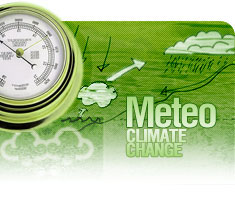The Biden administration is developing a controversial solar geoengineering research plan to the dismay of many experts
As global heating escalates, the US government has set out a plan to further study the controversial and seemingly sci-fi notion of deflecting the sun's rays before they hit Earth. But a growing group of scientists denounces any steps towards what is known as solar geoengineering.
The White House has set into motion a five-year outline for research into "climate interventions". Those include methods such as sending a phalanx of planes to spray reflective particles into the upper reaches of the atmosphere, in order to block incoming sunlight from adding to rising temperatures.
The work is required by Congress. It is "not new research, but a report that highlights some of the key knowledge gaps and recommendations of priority topics for relevant research", said a spokesperson for the White House's office of science and technology policy, adding Joe Biden's administration wants "effective and responsible CO2 removal" as well as deep cuts to greenhouse gas emissions.
Several American researchers, somewhat reluctantly, want to explore options to tinker with the climate system to help restrain runaway global heating, even as they acknowledge many of the knock-on risks aren't fully known. "Until recently, I thought it was too risky, but slow progress on cutting emissions has increased motivation to understand techniques at the margins like solar geoengineering," said Chris Field, who chaired a National Academies of Sciences report last year that recommended at least $100m being spent researching the issue.
"I don't think we should deploy it yet and there are still a ton of concerns, but we need to better understand it," Field said. "Climate change is causing widespread impacts, it's costing lives and wrecking economies. We are in a tough position; we are running out of time, so it's important we know more."
Previous attempts at running experiments for what is known as solar radiation management (SRM) have faced staunch opposition. Last year, an exploratory flight in Sweden of a high-altitude SRM balloon, led by Harvard University researchers, was halted after objections by environmentalists and Indigenous leaders.
But at least one US startup is now hoping to leap ahead with solar geoengineering.
Make Sunsets, backed by two venture capital funds, launched in October. It claims to have already run two internal test flights for its plan to inject sulphur via balloons into the stratosphere, more than 20km above the Earth's surface.
The venture, named after the deep red sunsets that would occur if particles were seeded into the stratosphere, says its "shiny clouds" will "prevent catastrophic global warming" and help save millions of lives. "Any human-caused release of carbon dioxide is geoengineering," it argues on its website, which asks people to buy "cooling credits" to fund its work. "We screwed up the atmosphere, and now we have a moral obligation to fix things!"
Edward Parson, an expert in environmental law at University of California, Los Angeles, says Make Sunsets' claims that it could return the world to its pre-industrial temperature for just $50bn a year are "absurd". He explains that most researchers are wary of deploying what they consider to be a desperate, last-ditch option.
But Parson says the risks in researching solar geoengineering have been overblown and that the US "is probably the bold leader on this. It would be a big step forward if we have a research program."
"In my opinion, the probability that a nation makes a serious effort on solar geoengineering over the next 30 years is about 90%," he adds. "As impacts get much worse and if mitigation doesn't massively increase, I judge it quite likely that some major nation considers its citizens are suffering climate harms that are intolerable."
This prospect horrifies opponents of solar geoengineering. An open letter signed by more than 380 scientists demands a global non-use agreement for SRM; it also says that growing calls for research in this area are a "cause for alarm", due to an unknown set of ramifications that will have varying consequences in different parts of the world and could scramble "weather patterns, agriculture and the provision of basic needs of food and water".
Frank Biermann, an expert in global governance at Utrecht University, said he's also disturbed that solar geoengineering will create a sort of moral hazard where governments ease off efforts to cut emissions and fossil fuel companies use it as cover to continue business as usual. Planet-heating emissions are expected to hit a record high this year, even though they must halve this decade if the world is to avoid dangerous levels of global heating.
"I would say the majority of scientists believe this is a crazy idea for a variety of reasons," said Biermann, who thinks the US is an outlier because of its own large per-capita emissions and inconsistent adherence to global agreements.
"Soon, everyone who is dependent on coal, oil and gas will jump on the solar engineering bandwagon and say, 'we can continue for 40 years with fossil fuels' now. This debate threatens to derail current climate policies. It's a huge risk."
Biermann likens research on blocking sunlight to the satirical movie Don't Look Up, in which researchers who warn of a catastrophic incoming meteoroid are sidelined in favor of an outlandish plan to deal with it. "The only way to find out whether this works is to do it to the whole planet for several years," he said.
"I mean will 8 billion people sit there in our living rooms having our last meal waiting and hoping that elite western universities got it right, that the Americans will not mess it up?"
There isn't any international governance around solar geoengineering for now. Critics fret that unilateral action to alter the climate could spark conflict if one part of the world benefits, while another suffers knock-on droughts or floods.
Also, the addition of aerosols would have to be continuous to maintain the cooling - any disruption, either intentional or otherwise, would cause a sort of "termination shock", where bottled up warming would be unleashed in a disastrously rapid jolt.
"Termination shock terrifies me," said Lili Fuhr, a climate and energy expert at the Center for International Environmental Law. "This is just a gigantic gamble with the systems that sustain life on Earth. It could be weaponized, it could be misused - imagine if, say, India and Pakistan disagreed over one of them doing this.
"We need to do more than just emissions cuts and I wish we had a magical fix to this, but this doesn't turn bad ideas into good ones," Fuhr adds.
The idea of recalibrating the world's climate to deal with heat-trapping emissions isn't new. A group of scientific advisers to Lyndon Johnson cautioned the US president about global heating in 1965, musing that "deliberately bringing about countervailing climatic changes therefore need to be thoroughly explored".
Calls for intervention have grown in recent years as countries continue to dawdle over emissions cuts and as an internationally agreed limit of 1.5C of global heating over pre-industrial times looms into view.
There are several types of proposed geoengineering, such as pumping a mist of salt water into clouds to make them more reflective of sunlight, or to place ice particles in high-altitude clouds to stop them trapping so much of the heat that bounces off Earth.
The most high-profile method, though, is firing a reflective substance such as sulphur or chalk dust from nozzles into the stratosphere, where the particles would then circulate around the world and start deflecting the sun's rays. David Keith, professor of applied physics and of public policy at Harvard, estimates that around 2m tons of sulphur a year, injected via a fleet of about 100 high-flying aircraft, would cool the planet by around 1C, around the amount it has heated up since the Industrial Revolution.
All of this would cost several billion dollars a year according to an estimate, and provide a relatively quick drop in temperatures. Keith argues it is more compelling than various carbon capture technologies that can take a long time and involve complex, expensive infrastructure. "Pretending that climate change can be solved with emissions cuts alone is a dangerous fantasy," Keith has stated.
We have lost so many easy paths to limit the harms of climate change that we only face worse options.
David Keith, professor of applied physics and of public policy at Harvard University
The basic physics of doing this is well understood, Parson said, likening it to the huge eruption of Mount Pinatubo in the Philippines in 1991, an event that expelled nearly 20m tons of sulphur dioxide into the stratosphere and caused global temperatures to drop temporarily by about 0.5C.
"Most people didn't notice that and there have been studies since that give us confidence it can be done," said Parson. "We don't know how it should be done, yet, and the environmental aspects and the governance remain concerns. It would be reckless to just start deploying this now but we have lost so many easy paths to limit the harms of climate change that we only face worse options."
Spraying sulphur into the skylight of the Earth could deplete the ozone layer, some have suggested, and perhaps make the sky a milky white color.
Other effects on regional weather are more uncertain, to the extent one recent novel based on the topic, The Ministry for the Future by Kim Stanley Robinson, depicted India embarking upon solar geoengineering to save itself from deadly heatwaves while another, Termination Shock by Neal Stephenson, conversely had India sabotaging a sulphur deployment system in Texas because it interfered with its monsoon.
The debate over how much we should meddle with the climate is likely to intensify as the fallout from global heating worsens. For now, opponents won't back down. To Biermann, solar geoengineering should be considered by governments as being akin to landmines or biological weapons and blacklisted internationally.
"This is just another one on this list," he said. "People talk about the freedom of research, but you don't have the freedom to sit in your back yard and develop a chemical bomb."



 Română
Română English
English


